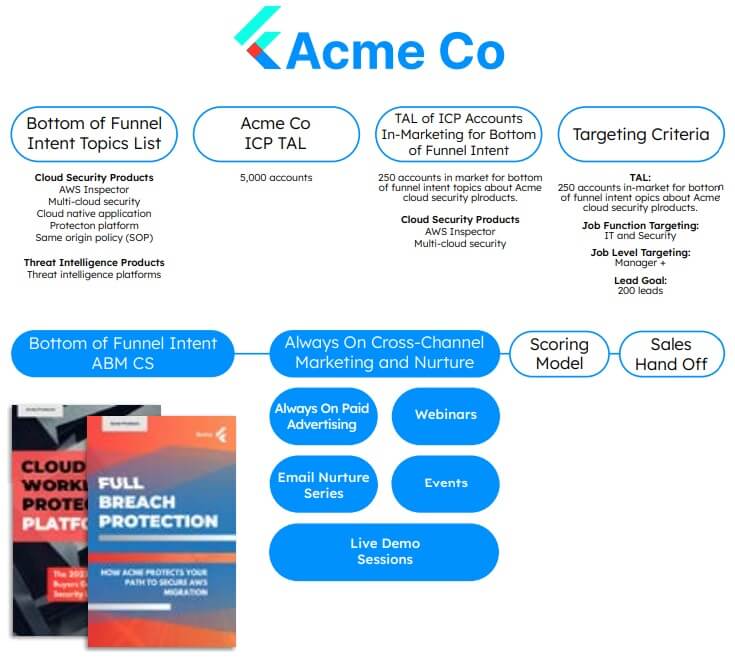Introducing account-based content syndication
Generating high-quality leads at the right price, volume, and pacing is a constant challenge for B2B marketers. To meet their lead goals, many marketers rely on content syndication as part of their marketing mix. But there are two familiar challenges with traditional content syndication programs. The first is that content syndication leads are not always a match to your company’s ideal customer profile (ICP). The second is that leads from traditional content syndication efforts commonly have low conversion rates, leaving marketers and sales teams frustrated. The problem is not with content syndication as a tactic. The problem is in the targeting.
Traditional content syndication doesn’t offer precise enough targeting for marketing teams that use an account-based approach. Account-Based Content Syndication (ABM CS) adds needed precision to this tactic. Instead of broad criteria such as company size or industry, ABM CS uses a target account list (TAL) to target content syndication programs, which has multiple benefits, including:
- More precise top funnel marketing.
- Generation of ICP leads.
- Predictable cost per lead, lead volume, and lead pacing.
- Control over lead acquisition.
- Activation of intent, ABM, and strategic programs.
Traditional content syndication
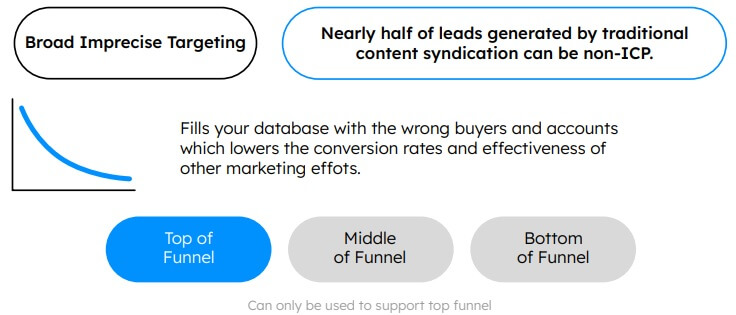
ABM content syndication
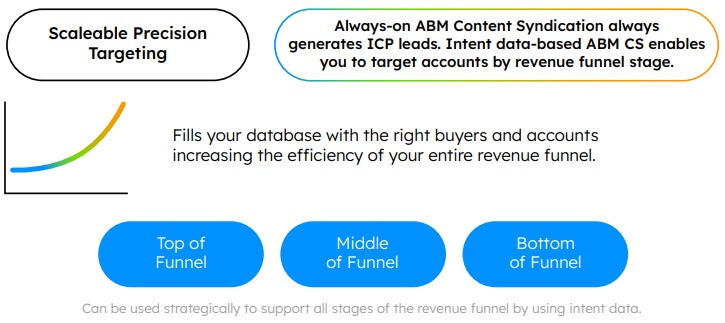
Create predictable pipeline with ABM CS
Unlike traditional content syndication, which is limited to early stage buying activity, ABM CS tactics can strategically support the entire revenue funnel. But to do more than provide suitable leads – to generate pipeline and revenue – they need to be used alongside:
- An always-on cross-channel marketing and nurture program engaging accounts, buying groups, and leads.
- A robust account-based marketing strategy.
- A scoring model to prioritise leads and accounts for sales follow-up.
This guide will walk you through four ABM CS tactics providing diagrams and using an example company named Acme Co. which we will use to show their (hypothetical) ABM CS programs.
- Always-on ABM content syndication.
- Top funnel intent ABM content syndication.
- Middle funnel intent ABM content syndication.
- Bottom funnel intent ABM content syndication.
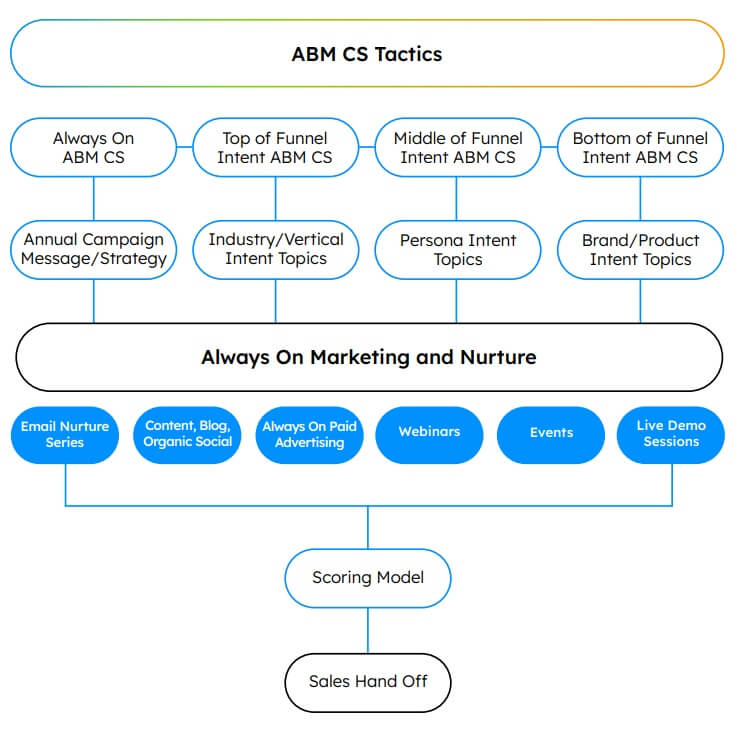
About Acme Co
Acme Co. is an imaginary B2B enterprise SaaS company that we’ll use to illustrate each ABM Content Syndication Tactic in this guide. Their revenue marketing team uses a unified ABM and demand marketing approach called Precision Demand Marketing (PDM).
Their PDM approach results in marketing that focuses on ICP accounts, acquires and engages buying groups, and delivers cross-channel journeys that are personalised and relevant to buyer groups.
We’ll follow along with examples of Acme Co. using each ABM Content Syndication tactic to create predictable pipeline for their SaaS Product, a Cyber Security Platform.
About Acme Co:
- Company Size: 1,200 employees.
- Location: North America.
- Industry: Cybersecurity Technology.
- Annual Revenue: £250 million.

Always On ABM CS
Always-on ABM content syndication is as simple as using a target account list to target your top funnel content syndication efforts. By doing so, you can change what was previously a broad-based demand effort into a tactic that aligns demand with ABM. With this tactic, all the top funnel responses you generate with content syndication will only include the right buyers from the right accounts.
Always-on ABM content syndication checklist:
- Align always-on ABM content syndication to annual strategic marketing plans considering criteria such as campaign, product, program, and goals.
- Develop a process for enrolling accounts engaged by always-on content syndication in cross-channel, always-on programs leveraging display ads, email nurturing, webinars, events, and other tactics to create cohesive experiences for buyers and buying groups.
- Ensure you dedupe and exclude accounts targeted by more specialised ABM CS tactics from your always-on ABM CS.
Follow along with Acme Co:
The diagram shows Acme Co.’s always-on ABM CS strategy for FY2023. Acme Co.’s always-on campaign message for the year is “Reduce the Risk of Ransomware.” Their content team is producing a set of six new eBooks, guides, and reports to support that campaign. Their always-on ABM CS program targets various job levels within the IT and Security functions of all their North America ICP target accounts. They enroll leads from their always-on ABM CS into their always-on cross-channel marketing and nurture to engage leads and buying groups. This program uses display ads, emails, webinars, and other tactics to drive engagement.
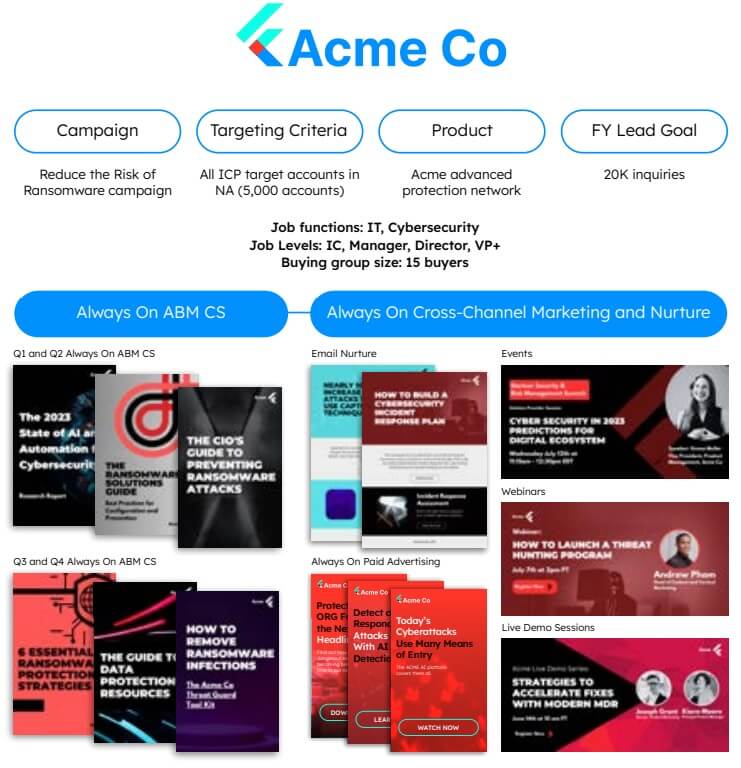
Top funnel intent ABM CS
By applying intent data to your target account list, you can identify active accounts early in their research process. Then you can target buyers from those accounts with the right message at the right time by using top of funnel intent ABM CS.
Top funnel intent checklist:
- Create your top funnel intent topics list by identifying relevant topics about your business category, including industry terms, capabilities, and use cases.
- Identify the content that is relevant to those topics.
- Apply the intent topic list to your TAL to find accounts surging on those topics, then segment those accounts into a smaller list for targeting and
deduplication against your always-on ABM CS. - Launch a personalised and relevant top funnel intent ABM CS program and nurture leads through your always-on marketing and nurture.
Follow along with Acme Co:
Acme Co. checks their target account list against their top funnel intent topics list and determines that 130 accounts show research intent for malware-related intent topics. They enroll those accounts in a top funnel intent ABM CS program that targets IT/Security job functions/titles and uses relevant content about malware. They also dedupe this list against their always-on ABM CS TAL.
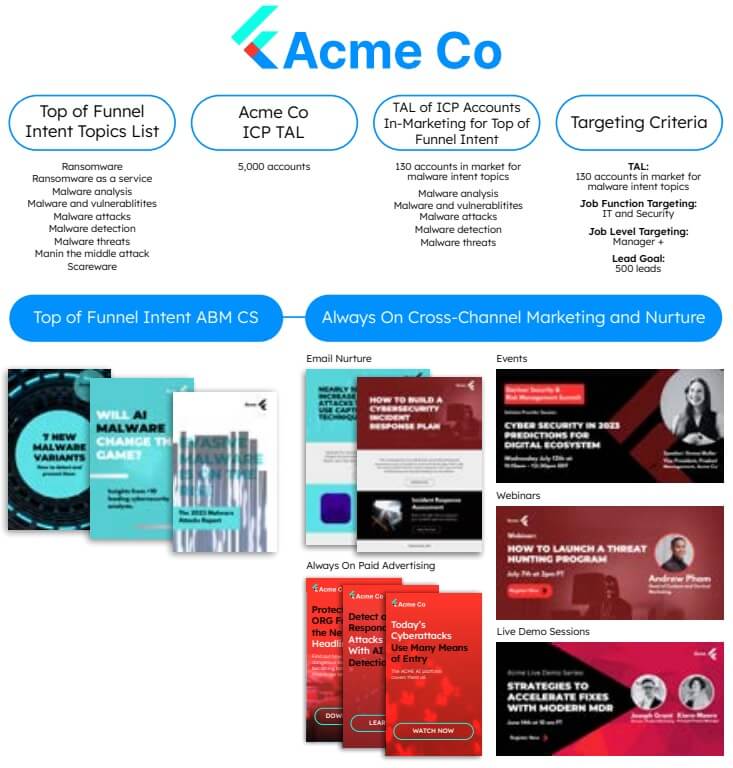
Middle funnel intent ABM CS
Today, B2B buyers make purchase decisions in buying groups. Marketing teams must identify, acquire, and engage buying groups to create a predictable pipeline. Middle funnel intent ABM CS helps you engage key buying personas with decisionmaking authority at your target accounts.
Middle funnel intent ABM CS checklist:
- Identify relevant middle funnel intent topics about topics important to the collective group of your key personas, such as buyer pain points, business issues, outcomes, results, tactics, and strategies, and organise topics by persona.
- Apply the intent topic list to your TAL to find accounts surging on those topics, then segment those accounts into a smaller list for targeting and deduplication against your always-on ABM CS.
- Select content relevant to the personas and intent topics, launch a personalised and relevant middle funnel intent ABM CS program, and nurture leads through your always-on marketing and nurture.
Follow along with Acme Co:
Acme Co. checks their target account list against their middle funnel intent topics list and determines that 425 accounts show research intent for managed detection and response related (MDR) intent topics. They enroll those accounts in a middle funnel intent ABM CS program that targets director + job levels within the security job function and uses relevant third-party analyst content. Because director+ cybersecurity buyers are a critical buying group member, Acme Co. Dedupes this TAL against their always-on ABM CS programs to ensure they reach them with relevant messaging.
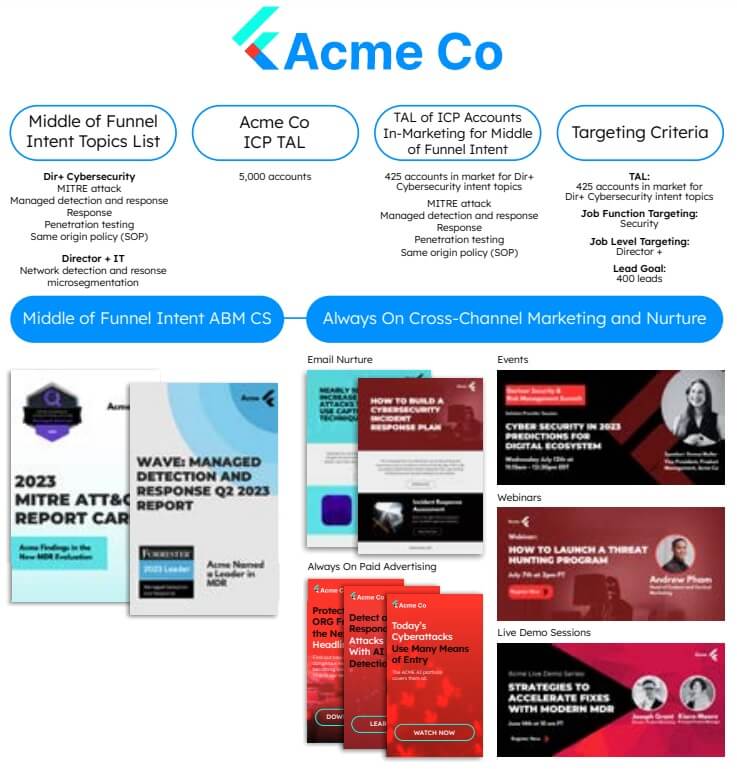
Bottom funnel intent ABM CS
Today’s B2B buyers conduct most of their research independently of sales, contacting them often only after they’ve made a decision. Bottom funnel intent ABM CS helps you reach buyers researching specific products with information about your offerings.
Bottom funnel intent ABM CS checklist:
- Identify relevant bottom funnel intent topics core to your business, including brand names, product names, service names, and critical business functions you perform for customers. Organise these intent topics by associated products or services.
- Apply the intent data to your TAL to find accounts surging on bottom funnel topics, then segment those accounts into a smaller list for targeting.
- Use job function and title to target the right buying group members.
- Launch a bottom funnel intent ABM CS program. Nurture or prioritise accounts, buying groups, or leads for sales follow-up according to your scoring model and processes.
Follow along with Acme Co:
Acme Co. checks their target account list against their bottom funnel intent topics and identifies that 250 accounts show research intent for bottom funnel topics related to cloud security products. They enroll those accounts in a bottom funnel intent ABM CS program that targets manager+ job titles from IT and security functions, and use cloud security solutions features and benefits content. They route buying groups to sales based on their account and lead scoring model.
